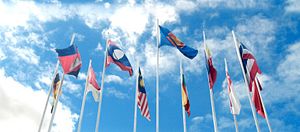In June 2010, Laos began receiving its first revenues from the sale of electricity to Thailand from its Nam Theun 2 Hydropower Project. Financed by a consortium of global and regional banks and multilateral and bilateral developmental agencies, the project was projected to generate an estimated $2 billion revenue over 25 years that would enable the government to fund programs to reduce poverty.
That same year, a video of the self-immolation of Tunisian vegetable vendor Mohammed al-Bouazizi went viral and sparked popular revolts across the Middle East and North Africa, ushering in years of still ongoing brutal and violent revolution and counterrevolution; civil wars in Syria, Yemen, and Libya; debilitating regional rivalries; and immense human suffering.
The contrast could not be sharper with Laos and other Southeast Asian nations like Vietnam that, in 2011, posted record growth in rice and coffee exports, making the country the second-biggest rice exporter after Thailand and the world’s second-largest coffee producer after Brazil.
Once the backyard of Cold War conflicts that played out in Laos, Cambodia, and Vietnam, Southeast Asia today is a prosperous region of opportunity that, unlike the Middle East, has been able to manage its conflicts and disputes and ensure that they do not pit nations against one another.
The battlefields of the 1960s and 70s have become vibrant competitive marketplaces, with formal and informal institutions to mediate and facilitate inter-regional relationships. Warriors of the past are today’s entrepreneurs and consumers. Current generations engage in the competition for market share rather than the struggle for military supremacy and territorial conquest. Political scientist Alex Bellamy calls it Asia’s “other miracle.”
Contrasting Development Strategies
Asia’s newfound economic vibrancy is rooted in sound development policies that promote stable macroeconomic environments, liberalization of trade regimes, open but well-regulated borders, managed budgets, and enthusiastic foreign investors enjoying tax benefits in designated free-trade zones. Anyone crossing the Friendship Bridge in Laos’ capital Vientiane can speedily continue into bustling Thailand’s cross-border market in Nong Khai — two bustling cities separated only by a thin sliver of the Mekong River. This short and simple journey epitomizes the transformation of trading relationships between the two countries that were not too long ago caught up in Cold War conflicts.
In contrast, rentier and nepotistic economic policies in the Arab world failed to yield similar results. Overall development in the Arab world, according to the 2015 UN Arab Development Report, makes for “dismal reading.” Youth unemployment is the highest in the world at 29 percent, female participation in the labor force is lowest at 23 percent. Palestine is one of the Arab world’s most painful development stories. The country’s GDP growth rate fluctuates wildly between -0.8 percent in 2008 to 20.9 percent in 2009.
In 2014, the growth rate fell to 1.9 percent. Gaza’s miniscule 1.8 million population cramped into 360 square kilometers of space suffers a 39 percent poverty rate and 41 percent unemployment rate, roughly twice as high as in the West Bank. Most recently, Gaza’s population enjoys electricity up to four hours a day.
By comparison, Laos, one of the poorest countries in Southeast Asia fares far better. As one of the most heavily-bombed countries in the region during the Vietnam war, Laos’ economic transition since the 1990s when it embraced market reforms shows steady positive results. Per capita incomes rose to $1537 in 2015, a dramatic increase from $405 in 1988.
The Undisputed Role of the State
Southeast Asia’s spectacular socioeconomic record has been achieved on the back of a relatively coherent and functioning state apparatus. Through statecraft and the implementation of public policy that is authoritative, rational, purposeful and premised on a developmental vision, the task of rebuilding society after a period of instability and social strife was achieved. Hence, central to the effort of achieving these goals was a state-led process of social and economic transformation.
Singapore’s exceptional record in establishing and maintaining a developmental state since separation from the Malayan Federation in 1965 has become a model to its neighbors as well as the Gulf states. Singapore achieved First World status in a very short period of 50 years, transforming its economy from an entrepot to a high-performing economy built on technological innovation and human resource development. This, despite its lack of natural resources, its small size, and its troubled political history.
In contrast, Middle Eastern economies have largely sputtered in their bid to transform the state into developmental ones, thereby lapsing either into rentier or impoverished countries stuck in a quagmire of corruption and patronage. To overcome this, the UN Human Development Report advocated for a new social contract that would grant citizens a wider role in societal affairs and “break the vicious pattern of dependence on the state that has been the hallmark of the Arab social contract.”
The Gathering Clouds
To be sure, Southeast Asia is not without its vulnerabilities. Success has come with numerous social costs, chief among these is the issue of environmental and social sustainability. Natural resources are steadily depleted to make way for urbanization. A growing aging population and low fertility rates are a challenge to relatively fragile social security systems.
Further, the Marawi siege in May 2017 in the southern Philippines signaled creeping sectarianism imported from the troublesome Middle East. The biggest challenge to the region is the as-of-yet unresolved Rohingya refugee crisis in Myanmar that could mirror that of Syria and become Southeast Asia’s Palestine. These are urgent matters that require a robust response to ensure that the region, built over decades of diplomacy and statesmanship does not unravel.
Teresita Cruz-del Rosario is Senior Research Associate at the Asia Research Institute, National University of Singapore. She was formerly Visiting Associate Professor at the Lee Kuan Yew School of Public Policy. She is co-author (with James M. Dorsey) of the recently published Comparative Transitions in Southeast Asia and the Middle East.

































